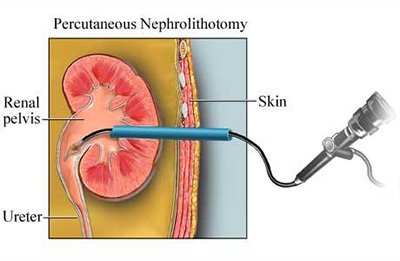Percutaneous Nephrolithotomy is a surgical treatment that removes kidney stones via a tiny incision in the back. The phrase “percutaneous” means “through the skin,” and “nephrolithotomy” is the removal of kidney stones. This procedure is most beneficial for stones that are too big (usually over 2 cm in diameter), too thick, or in a place where conventional treatments fail.
The PCNL Procedure
1.Preoperative Preparation: Prior to the procedure, a series of tests such as blood tests, urine tests, and imaging studies (like CT scans or X-rays) are conducted to determine the size, location, and number of kidney stones.
2. Anesthesia: Percutaneous Nephrolithotomy(PCNL) is usually performed under general anesthesia, meaning the patient will be asleep and pain-free during the procedure.
3. Accessing the Kidney: The surgeon makes a small incision in the patient’s back, creating a tract directly into the kidney. This tract allows the surgeon to insert a nephroscope (a thin telescope-like instrument).
4. Stone Removal: Using the nephroscope, the surgeon locates the kidney stones. Small stones may be removed whole, while larger stones are often broken up using specialized instruments, such as laser fibers or ultrasonic probes, before removal.
5. Postoperative Care: After the stones are removed, a temporary drainage tube (nephrostomy tube) might be placed in the kidney to help drain urine and any residual stone fragments or blood.
Recovery and Follow-up
Patients are often admitted to the hospital for 1–2 days following surgery for monitoring and early recuperation. Full recuperation often takes 1–2 weeks. During this time, patients may have some discomfort, which may be treated with prescription drugs.
Follow-up sessions are required to confirm that all stones have been effectively removed and to monitor kidney function. Imaging tests may be done to detect any leftover stone particles.
Benefits of PCNL
- Effective for Large Stones: PCNL is highly effective for treating large and complex kidney stones.
- Minimally Invasive: Compared to open surgery, PCNL involves a smaller incision, leading to reduced pain and quicker recovery times.
- High Success Rates: The procedure has a high success rate in removing stones and alleviating symptoms.
Risks and Considerations
PCNL, like any other surgical operation, has risks such as bleeding, infection, harm to nearby organs, and the chance of future procedures if all stones are not successfully removed. However, these dangers are often minor and are frequently surpassed by the advantages of eliminating the unpleasant and sometimes hazardous disease of kidney stones.
Conclusion
Percutaneous Nephrolithotomy (PCNL) is an important technique in the fight against kidney stones, providing a highly successful therapy for patients with big or complicated stones. If you or a loved one are dealing with kidney stones that are not responding to standard therapies, discussing PCNL with your healthcare physician may be the next best step toward relief and improved kidney health.






Comments